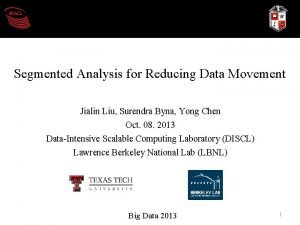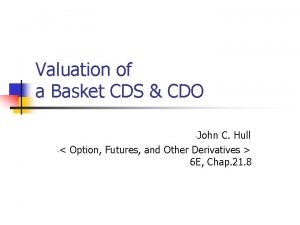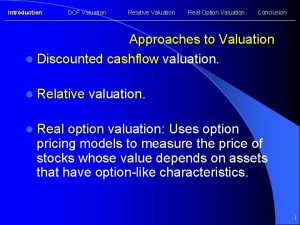CDO Valuation Term Structure Tranche Structure and Loss













![Marking CDO’s to market • V = [w(k, M) – wold(k, M)]Teff(k, M) • Marking CDO’s to market • V = [w(k, M) – wold(k, M)]Teff(k, M) •](https://slidetodoc.com/presentation_image/44b4174a2565be581f86857c9a655fb6/image-14.jpg)




- Slides: 18

CDO Valuation: Term Structure, Tranche Structure and Loss Distributions Michael Walker Department of Physics University of Toronto walker@physics. utoronto. ca

Global Credit Derivatives Market US$ bn (from BBA Credit Derivatives Report 2006)

Credit Derivatives Products

CDO’s – a simplistic view

CDO contracts provide insurance against tranche losses • e. g. consider 3 -6% tranche • Protection buyer buys insurance against all losses from 3 to 6% of total notional. • Protection buyer pays a regular quarterly premium to an investor • Investor pays any losses lying between 3% and 6% to the protection buyer

0 -3% quoted as upfront; remaining in bps per year (data from Julien Houdain and Fortis Investments)

Focus – The calibration problem • There can be 20 to 30 CDO contracts (differing in maturity and loss tranche) on the market that reference the same underlying portfolio. • The problem is to find a risk-neutral measure that can be calibrated to reproduce all available market prices. • This talk presents a simple solution to this calibration problem. • “base corr” can calibrate to only one maturity at a time (but to different tranches at that maturity). • It will be shown that accurate marking of tranches to market requires simultaneous calibration to all maturities. (Trading and RM)

The Basic Pricing Equation § For a CDO contract on a given tranche and for a given maturity, a fair premium requires that: PV(Expected tranche losses) = PV(Expected premium payments) § Define f(k, t) = expected loss per unit tranche notional for tranche k at time t

Expected loss for tranche k

Tranche term structures

Importance of accurate calibration • Market-standard copula and base correlations models don’t calibrate simultaneously to different maturities (i. e. to term structures). • Calibration across maturities is important because it fixes not only total losses, but the timing of the losses. • The timing of the losses has important effects on the mark-to-market values of CDO’s, and the values of forward-starting CDO’s, and options on CDO’s

The loss distribution F(l, t)

The ‘expected’ risk-neutral recovery rate for the basket as a function of time
![Marking CDOs to market V wk M woldk MTeffk M Marking CDO’s to market • V = [w(k, M) – wold(k, M)]Teff(k, M) •](https://slidetodoc.com/presentation_image/44b4174a2565be581f86857c9a655fb6/image-14.jpg)
Marking CDO’s to market • V = [w(k, M) – wold(k, M)]Teff(k, M) • w(k, M) is the annualized premium paid for protection on tranche k of maturity M • Teff(k, M) is the risky duration of the premium payments • Timing of losses …

Mark-to-market 10 yr maturity

FCDO Term structures

CDO options on 3 -6% tranche

Conclusions - Results • Perfect calibration to any set of market prices for CDO’s that is arbitrage-free • Mark-to-market prices for CDO tranches that are as reliable as possible • Pricing of bespoke CDO tranches on standard baskets has been carried out. • A recent extension incorporates dynamics and values FCDO’s and options on CDO’s
 Cdo valuation
Cdo valuation Cdo valuation
Cdo valuation Tranş arabası
Tranş arabası Codification sequentielle
Codification sequentielle Jose luis tranche
Jose luis tranche Cdo ensmean
Cdo ensmean Synthetic cdo
Synthetic cdo Fixed income valuation methods
Fixed income valuation methods Scrap account
Scrap account Property valuation certificate by chartered accountant
Property valuation certificate by chartered accountant Valuation of long term securities
Valuation of long term securities Short, medium and long term planning in education
Short, medium and long term planning in education Short term and long term human resource planning
Short term and long term human resource planning Difference between long term and short term liabilities
Difference between long term and short term liabilities Accounting for serial bonds
Accounting for serial bonds Short term goals examples
Short term goals examples Long term and short term financial planning
Long term and short term financial planning Term-to-term rule
Term-to-term rule Long term memory vs short term memory
Long term memory vs short term memory


































